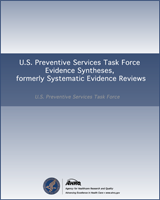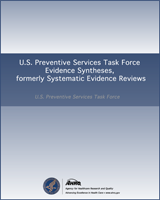NCBI Bookshelf. A service of the National Library of Medicine, National Institutes of Health.
This publication is provided for historical reference only and the information may be out of date.
Structured Abstract
Context:
Family and intimate partner violence occurs commonly in the U.S. and causes important health problems. Although the clinician's role in identification and intervention is considered a professional and legal responsibility, the effectiveness of these efforts is unclear.
Objective:
To examine evidence on the performance of screening procedures and interventions in the primary care setting in reducing harm from family and intimate partner violence for children, women, and elderly adults.
Data Sources:
MEDLINE®, PsycINFO, CINAHL, Health & Psychosocial Instruments, ERIC, AARP Ageline, and the Cochrane Controlled Trials Register, reference lists of systematic reviews, and experts.
Study Selection:
Included studies had English-language abstracts, were applicable to U.S. clinical practice, described abuse and neglect in women, children, or elderly adults, were conducted in or linked to primary care, obstetrics/gynecology, or emergency department settings, and included a clinician in the process of assessment or intervention.
Data Extraction:
We extracted selected information about study design, patient samples and settings, methods of assessment or intervention, and clinical endpointsand applied a set of criteria to evaluate study quality.
Data Synthesis:
No studies directly addressed the effectiveness of screening in a healthcare setting in reducing harm, or described the adverse effects of screening and interventions. All instruments designed to screen for child abuse and neglect were directed to parents, particularly pregnant women. These had fairly high sensitivity but low specificity. Several brief instruments designed to identify women with intimate partner violence compared well to longer previously validated instruments. We found few studies of screening for elder abuse and neglect. A randomized controlled trial with 15-years follow-up indicated that nurse home visits during pregnancy and for 2-years postpartum for low-income women improved abuse and neglect outcomes for children. Studies of interventions for children of other ages, women who are not pregnant, and elderly adults are lacking.
Conclusions:
Screening and interventions for child abuse are directed to parents during prenatal and postpartum periods. Several brief screening instruments have been tested for women, but interventions are lacking. Few instruments and no interventions were identified for elderly adults.
Contents
This systematic evidence review was prepared for the Agency for Healthcare Research and Quality1 (contract #290-97-0018, task order no. 2) to be used by the U.S. Preventive Services Task Force. Prepared by: Oregon Health & Science University Evidence-based Practice Center.2
This report may be used, in whole or in part, as the basis for development of clinical practice guidelines and other quality enhancement tools, or a basis for reimbursement and coverage policies. AHRQ or U.S. Department of Health and Human Services endorsement of such derivative products may not be stated or implied.
AHRQ is the lead Federal agency charged with supporting research designed to improve the quality of health care, reduce its cost, address patient safety and medical errors, and broaden access to essential services. AHRQ sponsors and conducts research that provides evidence-based information on health care outcomes; quality; and cost, use, and access. The information helps health care decisionmakers—patients and clinicians, health system leaders, and policymakers—make more informed decisions and improve the quality of health care services.
- 1
U.S. Department of Health and Human Services, 540 Gaither Road, Rockville, MD 20850. www
.ahrq.gov - 2
3181 SW Sam Jackson Park Road, Portland, OR 97239.
- Review Screening women and elderly adults for family and intimate partner violence: a review of the evidence for the U. S. Preventive Services Task Force.[Ann Intern Med. 2004]Review Screening women and elderly adults for family and intimate partner violence: a review of the evidence for the U. S. Preventive Services Task Force.Nelson HD, Nygren P, McInerney Y, Klein J, U. S. Preventive Services Task Force. Ann Intern Med. 2004 Mar 2; 140(5):387-96.
- Review Screening Women for Intimate Partner Violence and Elderly and Vulnerable Adults for Abuse: Systematic Review to Update the 2004 U.S. Preventive Services Task Force Recommendation[ 2012]Review Screening Women for Intimate Partner Violence and Elderly and Vulnerable Adults for Abuse: Systematic Review to Update the 2004 U.S. Preventive Services Task Force RecommendationNelson HD, Bougatsos C, Blazina I. 2012 May
- Review Screening for Cognitive Impairment in Older Adults: An Evidence Update for the U.S. Preventive Services Task Force[ 2013]Review Screening for Cognitive Impairment in Older Adults: An Evidence Update for the U.S. Preventive Services Task ForceLin JS, O'Connor E, Rossom RC, Perdue LA, Burda BU, Thompson M, Eckstrom E. 2013 Nov
- Review Screening children for family violence: a review of the evidence for the US Preventive Services Task Force.[Ann Fam Med. 2004]Review Screening children for family violence: a review of the evidence for the US Preventive Services Task Force.Nygren P, Nelson HD, Klein J. Ann Fam Med. 2004 Mar-Apr; 2(2):161-9.
- Review Screening for Intimate Partner Violence, Elder Abuse, and Abuse of Vulnerable Adults: Evidence Report and Systematic Review for the US Preventive Services Task Force.[JAMA. 2018]Review Screening for Intimate Partner Violence, Elder Abuse, and Abuse of Vulnerable Adults: Evidence Report and Systematic Review for the US Preventive Services Task Force.Feltner C, Wallace I, Berkman N, Kistler CE, Middleton JC, Barclay C, Higginbotham L, Green JT, Jonas DE. JAMA. 2018 Oct 23; 320(16):1688-1701.
- Screening for Family and Intimate Partner ViolenceScreening for Family and Intimate Partner Violence
- Solanum oedipus voucher Martine 814A (CONN) internal transcribed spacer 1, 5.8S ...Solanum oedipus voucher Martine 814A (CONN) internal transcribed spacer 1, 5.8S ribosomal RNA gene, and internal transcribed spacer 2, complete sequencegi|85838674|gb|DQ364729.1|Nucleotide
- Cerdia sp. Escamilla et al. 152 18S ribosomal RNA gene, partial sequence; intern...Cerdia sp. Escamilla et al. 152 18S ribosomal RNA gene, partial sequence; internal transcribed spacer 1 and 5.8S ribosomal RNA gene, complete sequence; and internal transcribed spacer 2, partial sequencegi|58201006|gb|AY857962.1|Nucleotide
Your browsing activity is empty.
Activity recording is turned off.
See more...

